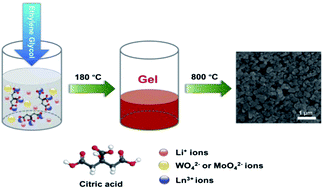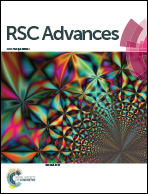General synthesis of LiLn(MO4)2:Eu3+ (Ln = La, Eu, Gd, Y; M = W, Mo) nanophosphors for near UV-type LEDs†
Abstract
A series of Eu3+-doped double tungstate and molybdate red phosphors, LiLn(MO4)2:Eu3+ (Ln = La, Eu, Gd, Y; M = W, Mo), have been successfully synthesized by a simple Pechini method. The procedure involves formation of homogeneous, and transparent, metal–citrate gel precursors using citric acid as a chelating ligand to form metal complexes and ethylene glycol as a cross-linker for polyesterification with the complexes, followed by calcination to promote thermal decomposition of the gel precursors to yield the final LiLn(MO4)2 nanoparticles. The as-synthesized nanoparticles were characterized by thermogravimetric/differential scanning calorimetry (TG-DSC), X-ray diffraction (XRD), scanning electron microscopy (SEM), and photoluminescence (PL) as well as kinetic decay. The results indicate that the obtained LiLn(MO4)2:Eu3+ samples crystallize in the isostructure with tetragonal space group I41/a (no. 88). A room temperature PL spectrum shows that Eu3+-doped LiLn(MO4)2 powders exhibit an excellent luminescent properties under a near ultraviolet excitation wavelength of 395 nm, suitable for near UV type LEDs. By comparing with other counterparts, it is found that LiEu(WO4)2 and LiEu(MoO4)2 display the highest emission intensity. In addition, the phosphor of composition LiY0.95Eu0.05(WO4)2 shows promising application for white light emission with a decay time of 0.585 ms.


 Please wait while we load your content...
Please wait while we load your content...